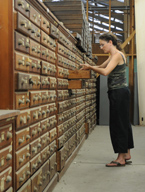Fossil Treasure Troves
March 24, 2011

Despite a shift over the past century from a focus on invertebrate research and education to mainly vertebrates, the university retains a world class collection of 4.5 million invertebrate specimens, many collected by graduate students, others as part of early state geologic surveys. Of those, 20,000 are type specimens, those used to define the characteristics of new species in the scientific literature.
One of the key strengths of the invertebrate collection is its breadth. Ann Molineux, collections manager of the Non-vertebrate Paleontology Laboratory (NPL), notes geologists doing early field mapping projects collected a broad range of specimens representative of entire formations.
“They weren’t just focused on getting the prettiest specimens,” she says. “The collection that came from that is fabulous because it’s huge, it contains a vast range of different shapes, forms, and sizes. It contains juveniles and adults of different species that provide a wealth of information for anybody wanting to see variability in a particular species.”
Papers referencing specimens in these collections have increased substantially in the past decade, despite less emphasis on invertebrates within the university. Molineux attributes the increase to heightened interest from outside the university.
Scientists from north Texas recently spent several days going through a group of Texas mussels collected in the late 1800s and early 1900s, now housed in the NPL. By comparing the species and distributions of mussels from then and now, they hope to learn how changes in land use and pollution impact stream ecology.
Molineux is working to make the invertebrate collections more accessible by creating an online digital catalog and photographing the most scientifically valuable specimens.
Meanwhile, the Vertebrate Paleontology Laboratory (VPL), which houses one million specimens, is known worldwide as a major repository for unique scientific collections from the American Southwest. The VPL contains rich Quaternary cave deposits from locations such as Hall’s Cave and Friesenhahn Cave, site of a famous discovery of scimitar- toothed cats in 1949. The VPL collections also include thousands of modern skeletal specimens for comparative studies. In recent years, the VPL has also absorbed orphaned collections from around the state.
While the VPL and NPL are in many ways unique, they share a common challenge of preserving vast collections for future generations. Ironically, specimens that survived millions of years in the Earth can, depending on their composition, quickly fall apart when they experience the swings in humidity and temperature common in Texas. Yet large parts of the collections are stored without adequate climate control due to a lack of space and budgetary constraints. It’s a common problem at large paleontology collections across the country.
Still, fossil collections are critical for a strong paleontology program. Even when the original research project is “over” and the results are published, the specimens can still serve an important role in science. New technologies, such as CT scanning, make it possible to mine classic specimens such as the primitive bird Archeopteryx or the early human ancestor Lucy for additional information.
Molineux and Tim Rowe, who directs the VPL , agree that it would be a tragedy, not just for the university but for science in general, to let these world class collections deteriorate. Rowe says a fossil collection is really a research instrument.
“I think a lot of people wonder, ‘Why do we keep all these old fossils around?'” he says. “But no one ever asks, ‘Why do we have the McDonald Observatory?'”
He thinks of the university’s astronomical observatory as a beehive, drawing researchers and students from around the world. “A collection is an instrument in exactly the same sense,” he says.
by Marc Airhart
>>> Return to “Enduring Excellence”
For more information about the Jackson School contact J.B. Bird at jbird@jsg.utexas.edu, 512-232-9623.
